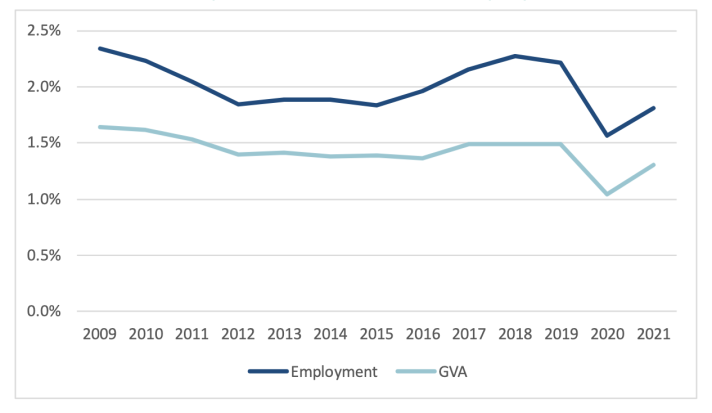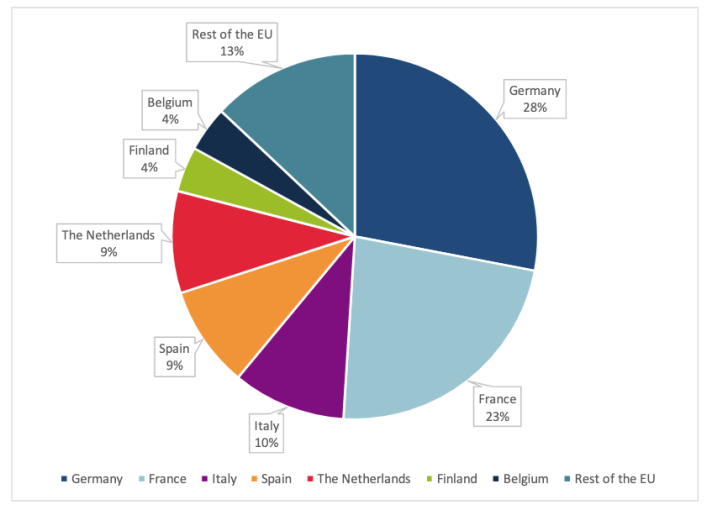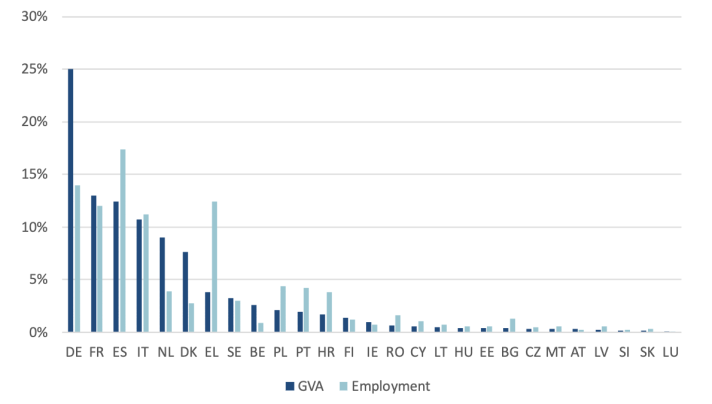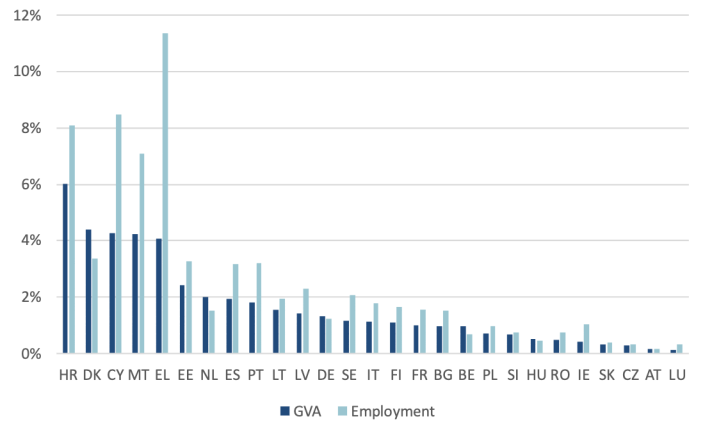
EU funding and policy instruments foster blue innovation, research and entrepreneurship, in turn bringing growth to the blue economy, and creating new jobs and economic opportunities. The trend is expected to continue, also thanks to falling energy prices since 2023 and declining inflation, according to the seventh edition of the Blue Economy report, published today.
The report looks back on progress since 2009 and tracks developments between 2020 and 2021 (latest available data from Eurostat). According to the most recent figures, in 2021 the blue economy was on recovery path from the pandemic: the gross operating surplus (profit) grew by 73% as compared to 2020, reaching €76.4 billion, while employment went up by 17%, representing a 1.8% share of EU’s workforce.
The established sectors of the EU blue economy directly employed close to 3.59 million people and generated around €623.6 billion in turnover and €171.1 billion in gross value added (GVA).
These established sectors include marine living resources, marine non-living resources, marine renewable energy, port activities, shipbuilding and repair, maritime transport and coastal tourism. Coastal tourism retained the largest share employment and gross value added in the EU blue economy, with 54% and 29%, respectively, even though still recovering from the 2020 pandemic crisis.
The substantial rebound confirms the EU Blue Economy in 2021 was on its way towards its pre-pandemic value but falling short of the €186.8 billion in GVA registered in 2019 primarily due to the incomplete recovery of coastal tourism, as travel restrictions were still in place in several EU countries.
Marine living resources and marine renewable energy – mainly offshore wind – performed particularly well, achieving respectively 24% and 45% increase of gross profits as compared to 2020. Marine renewable energy is the fastest-growing sector in relative terms, and probably one of the fastest-growing in the EU economy as a whole. The turnover of this sector grew from €91 million in 2009 to €3.4 billion in 2021 in nominal terms.
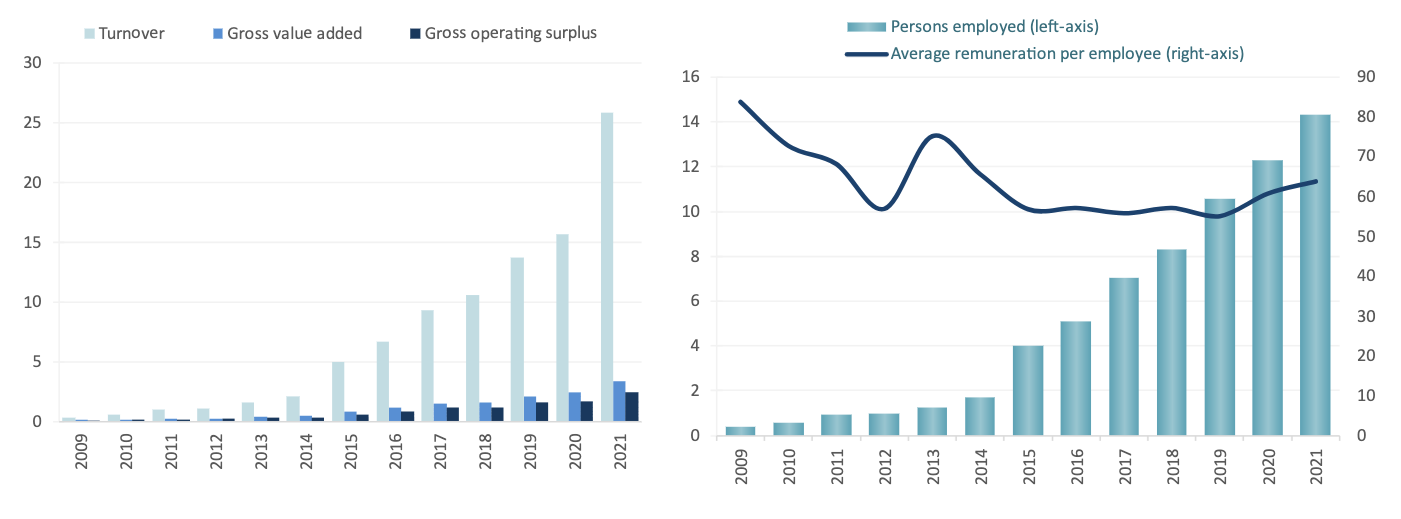
Looking further back, most of the EU blue economy sectors improved their economic performance. Between 2015 and 2021, there has been a marked increase in nominal GVA for the offshore wind energy (+ 326%), shipbuilding and repair (+ 54%), maritime transport (+ 29%), marine living resources (+ 27%) and port activities (+ 11%).
Innovation and new technologies
The EU’s ambitious decarbonisation targets for the blue economy sectors are driving new business opportunities. Examples are the development and use of clean technologies and fuels. Data shows fuel consumption and CO2 emissions of the EU fishing fleet decreased by 25% between 2009 and 2021, though higher fuel prices post-pandemic have brought about a setback.
Ocean energy, blue biotechnology and desalination are innovative, emerging blue economy sectors offering potential for economic growth, jobs creation and green transition. The latter two show comparatively higher growth rates.
Innovative ocean energy technologies offer complementary solutions for marine energy production in addition to offshore wind. Projects that harness tidal, wave, ocean thermal energy conversion, and salinity gradient from the oceans attract both public and private investment in the EU. Tidal energy is the first of such alternative ocean energy sources to have reached large scale commercial applications (e.g. in France since 1966).
Several wave energy technologies are at different stages of development (e.g. in Portugal and Sweden) or deployment (e.g. in Spain and Italy), while salinity gradient power (using salt content differences between fresh and saltwater) is being tested in several European sea basins. Europe is at the forefront of the ocean energy sector, with almost two thirds of the global capacity located within EU sea basins.
In terms of applications, the medical and pharmaceutical sectors are at the forefront of blue biotechnology development both in the EU and worldwide. Germany (28%) and France (23%) alone make slightly more than half of the EU market value and are also projected to grow faster than the other EU countries.
Desalination is a rapidly emerging sector which addresses water scarcity. The European desalination market is expected to expand, not only to address freshwater shortages imposed by climate change, but also to harness technological developments that allow to reduce operational costs and environmental impacts.
An example is the investment plan of more than €12 billion announced by the Spanish government in 2023 for the construction of desalination plants and the improvement of water infrastructure.
EU countries and the blue economy
The four largest EU countries – Germany, Spain, Italy and France – are also the largest contributors to the EU blue economy.
The share of the blue economy in national economies varies across EU countries, as the blue economy of insular countries or those with archipelagos are greater contributors to the national GVA and employment. In terms of employment, shares range from 11.4% in Greece to 0.2% in Austria. When it comes to GVA, the range extends from 6% in Croatia to 0.1% in Luxembourg.
The report also includes a section on the impacts of coastal flooding along the EU-27 coastline. Around 72,000 people in the EU are exposed to coastal flooding every year, while economic damages amount to €1 billion annually. With global warming, damages are projected to rise sharply if current levels of coastal protection aren’t raised. By 2100, annual damages would amount to €137 billion and €814 billion under a moderate mitigation and high emission scenarios respectively.
Background
The EU Blue Economy report is an annual publication compiled by the JRC and the European Commission’s Directorate-General for Maritime Affairs and Fisheries. It thoroughly examines the scale and breadth of the Blue Economy within the EU, offering guidance to policymakers and stakeholders in fostering the sustainable progress of oceans and coastal resources.
The report focuses on analysis, trends and drivers of the Blue Economy sectors, including marine living and non-living resources, marine renewable energy (offshore wind), port activities, shipbuilding and repair, maritime transport and coastal tourism. It also offers relevant information on innovative blue economy sectors, such as desalination and blue biotechnology.
In addition, this year’s edition includes a section on energy transition and climate change in the EU maritime transport sector, on the EU fishing fleet and the partnership in fisheries and aquaculture, as well as a section on coastal flood impacts due to climate change along the EU27 coastline.
Data and analysis from the EU Blue Economy Observatory platform feed into the report. The observatory provides timely and regular updates of the blue economy data per sector, EU-27 Member State and sea basin.
Related links
The EU Blue Economy report 2024
EU Blue Economy report 2024: innovation and sustainability drive growth
Details
- Publication date
- 30 May 2024
- Author
- Joint Research Centre
- JRC portfolios

